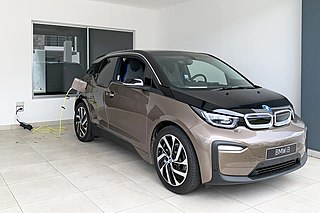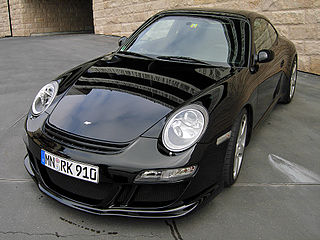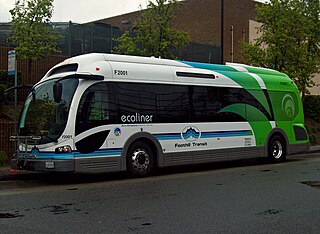Related Research Articles

A hybrid vehicle is one that uses two or more distinct types of power, such as submarines that use diesel when surfaced and batteries when submerged. Other means to store energy include pressurized fluid in hydraulic hybrids.

An electric vehicle (EV) is a vehicle whose propulsion is powered fully or mostly by electricity. EVs include road and rail vehicles, electric boats and underwater vessels, electric aircraft and electric spacecraft.

Eaton Corporation plc is an American-Irish-domiciled multinational power management company, with a primary administrative center in Beachwood, Ohio. Eaton has more than 85,000 employees and sells products to customers in more than 175 countries.

The Hyundai Motor Group is a South Korean chaebol headquartered in Seoul, South Korea.

A fuel cell vehicle (FCV) or fuel cell electric vehicle (FCEV) is an electric vehicle that uses a fuel cell, sometimes in combination with a small battery or supercapacitor, to power its onboard electric motor. Fuel cells in vehicles generate electricity generally using oxygen from the air and compressed hydrogen. Most fuel cell vehicles are classified as zero-emissions vehicles. As compared with internal combustion vehicles, hydrogen vehicles centralize pollutants at the site of the hydrogen production, where hydrogen is typically derived from reformed natural gas. Transporting and storing hydrogen may also create pollutants. Fuel cells have been used in various kinds of vehicles including forklifts, especially in indoor applications where their clean emissions are important to air quality, and in space applications. Fuel cells are being developed and tested in trucks, buses, boats, ships, motorcycles and bicycles, among other kinds of vehicles.

A solar electric vehicle is an electric vehicle powered completely or significantly by direct solar energy. Usually, photovoltaic (PV) cells contained in solar panels convert the sun's energy directly into electric energy.

Safran S.A. is a French multinational aerospace, defence and security corporation headquartered in Paris. It designs, develops and manufactures both commercial and military aircraft engines; launch vehicle, spacecraft and missile propulsion systems; as well as various other aerospace and military equipment and devices. The company was founded in 2005 through a merger between the aerospace engine manufacturer SNECMA and the electronics specialist SAGEM. Safran's subsequent acquisition of Zodiac Aerospace in 2018 significantly expanded its aeronautical activities.

Ruf Automobile GmbH is a German car manufacturer. Formerly using Porsche bodies in white to build cars, today they build vehicles on their own bodies and chassis. They also manufacture performance parts for various Porsche models, including the 911, Boxster, and Cayman.

The FreedomCAR and Vehicle Technologies (FCVT) was a national Office of Energy Efficiency and Renewable Energy program developing more energy-efficient and environmentally-friendly highway transportation technologies to enable the United States to use less petroleum. Run by Michael Berube, it had long-term aims to develop "leap-frog" technologies to provide Americans with greater freedom of mobility and energy security, lower costs, and reduce environmental impacts.

Gillig is an American designer and manufacturer of buses. The company headquarters, along with its manufacturing operations, is located in Livermore, California. By volume, Gillig is the second-largest transit bus manufacturer in North America. As of 2013, Gillig had an approximate 31 percent market share of the combined United States and Canadian heavy-duty transit bus manufacturing industry, based on the number of equivalent unit deliveries.

An electric aircraft is an aircraft powered by electricity. Electric aircraft are seen as a way to reduce the environmental effects of aviation, providing zero emissions and quieter flights. Electricity may be supplied by a variety of methods, the most common being batteries. Most have electric motors driving propellers or turbines.

A hydrogen-powered aircraft is an aeroplane that uses hydrogen fuel as a power source. Hydrogen can either be burned in a jet engine or another kind of internal combustion engine, or can be used to power a fuel cell to generate electricity to power an electric propulsor. It cannot be stored in a traditional wet wing, and hydrogen tanks have to be housed in the fuselage or be supported by the wing.
Hybrid vehicle drivetrains transmit power to the driving wheels for hybrid vehicles. A hybrid vehicle has multiple forms of motive power, and can come in many configurations. For example, a hybrid may receive its energy by burning gasoline, but switch between an electric motor and a combustion engine.

A battery electric vehicle (BEV), pure electric vehicle, only-electric vehicle, fully electric vehicle or all-electric vehicle is a type of electric vehicle (EV) that uses electrical energy exclusively from an on-board battery pack to power one or more electric traction motors, on which the vehicle solely relies for propulsion. This definition excludes hybrid electric vehicles, which use internal combustion engines (ICEs) in adjunct to electric motors for propulsion; and fuel cell electric vehicles (FCEVs) and range-extended electric vehicles (REEVs), which consume fuel through a fuel cell or an ICE-driven generator to produce electricity needed for the electric motors. BEVs have no fuel tanks and replenish their energy storage by plugging into a charging station or electrical grid, and use motor controllers to modulate the output engine power and torque, thus eliminating the needed for clutches, transmissions and sophisticated engine cooling as seen in conventional ICE vehicles. BEVs include – but are not limited to – all battery-driven electric cars, buses, trucks, forklifts, motorcycles and scooters, bicycles, skateboards, railcars, boat and personal watercraft, although in common usage the term usually refers specifically to passenger cars.

The eRuf Model A is a late-2000s all-electric concept sports car built by German automobile manufacturer Ruf Automobile. The car was powered by a UQM Technologies propulsion system. The car has a top speed of 225 km/h (140 mph) and was capable of producing 150 kW of power and 479 lb⋅ft (649 N⋅m) of torque. Estimated range per charge was 250–320 km (155–199 mi), depending on performance level, using iron-phosphate, lithium-ion batteries built by Axeon plc of Great Britain. During coasting the engine works as a generator producing electricity to charge the batteries.
Intelligent Energy is a fuel cell engineering business focused on the development, manufacture and commercialisation of its proton-exchange membrane fuel cell technologies for a range of markets including automotive, stationary power, materials handling equipment and UAVs. Headquartered in the UK with representation in the US, Japan, South Korea, and China.
A hybrid electric aircraft is an aircraft with a hybrid electric powertrain. As the energy density of lithium-ion batteries is much lower than aviation fuel, a hybrid electric powertrain may effectively increase flight range compared to pure electric aircraft. By May 2018, there were over 30 hybrid electric aircraft projects, and short-haul hybrid-electric airliners were envisioned from 2032.

An electric vertical take-off and landing (eVTOL) aircraft is a variety of VTOL aircraft that uses electric power to hover, take off, and land vertically. This technology came about owing to major advances in electric propulsion and the emerging need for new aerial vehicles for urban air mobility that can enable greener and quieter flights. Electric and hybrid propulsion systems (EHPS) have also the potential of lowering the operating costs of aircraft.

The Proterra EcoRide BE35 is a 35 foot (11 m) fast-charge battery electric bus that seats 38 with a total passenger capacity of 60 in its composite low floor body. Foothill Transit was the first transit agency to operate the buses in revenue service, starting in September 2010. It is the first 30 ft (9 m) or larger, heavy-duty all-electric bus ever to complete federally required durability, reliability and safety testing at the Bus Research and Testing Center in Altoona, Pennsylvania. The 12yr/500,000 miles (800,000 km) STURAA test was completed on March 5, 2012.
References
- ↑ World Cars. [S.l.]: Herald Bks. 1982. p. 53. ISBN 0910714142.
- ↑ "CUQM Technologies Receives Award From the U.S. Navy".
- ↑ "UQM Technologies Inc". Business Week. Archived from the original on October 25, 2012. Retrieved 11 September 2012.
- ↑ "Ruf's electric Porshce powered by UQM motor". Autoblog.com . 21 October 2008. Retrieved 11 September 2012.
- ↑ "Boeing Flies First Fuel-Cell-Powered Manned Aircraft". Sustainable Business. 16 April 2008. Retrieved 11 September 2012.
- ↑ "Biden to visit Colo. tech company to plug stimulus". Business Week. 29 April 2010. Archived from the original on April 2, 2015. Retrieved 11 September 2012.
- ↑ "UQM Technologies Announces Closing of Merger with Danfoss" (Press release). Business Wire. July 31, 2019.